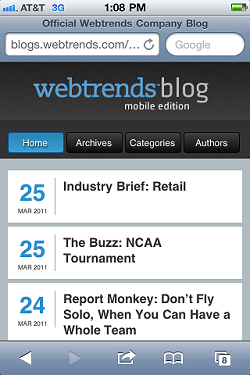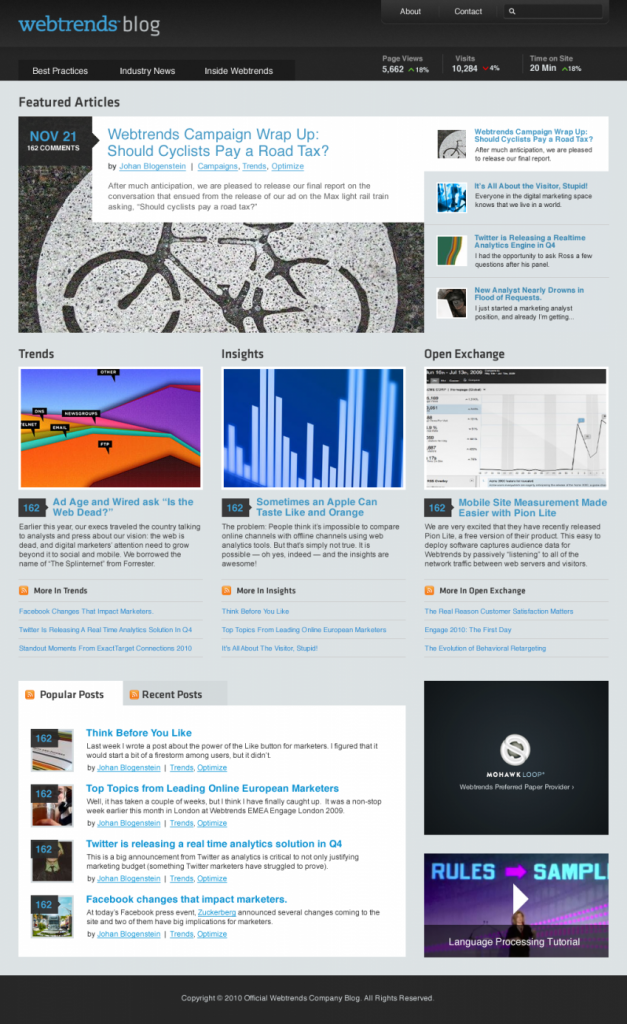It used to be that the marketing department was a cost center. You have a budget and track what you spent each year, adjusting the marketing mix accordingly. CMOs focused on raw tonnage—GRPs, impressions, number of media mentions, and so forth. But painfully missing in the equation was revenue—the kinds of stuff the CEO and CFO care about.

In fact, the board doesn’t care about how many Facebook fans you have, the number of tradeshows you exhibited at, or how many people stopped by your booth. They want to know revenue and ROI. Can you forecast with confidence what would happen to your marketing metrics if you suddenly doubled your marketing budget overnight? Can you quantify the ROI of your efforts in the same way that the sales organization can?
The underlying trend here is that
marketing is measurable. Web analytics tools when used properly allow you to transform yourself from a cost center to a revenue center. Crown yourself as Chief Revenue Officer so that you can focus on results instead of efforts, on revenue instead of costs, on ROI vs. on number of impressions served, on leads generated vs. how you rank on a particular keyword.
When you are seen as a cost center, the CEOs natural reaction is manage you downward—“Hey, try not to spend too much money, okay?” Conceptually, we can agree that marketing’s efforts must be doing something good to enhance the brand and generate attention that somewhere down the line results in more sales. To what degree, nobody has really been able to tell until now.
THE MISSING LINKS
Lead nurturing and marketing automation tools like Marketo and salesforce.com allow you to tie marketing costs against revenue generated. And web analytics will help you associate activities further up the funnel with marketing campaigns, so you know what happens when they became a lead. But that’s not enough. Companies need the following:
Email address collection: Let’s say you’re running some Facebook campaigns or perhaps a contest of sorts. Sure, you generated a lot of traffic, but did it result in long-lasting value and revenue? Were these customers higher or lower value than what you get via other channels? Facebook’s extended permissions allow you to get a fan’s email address in just one click. They need only click “allow”, which they’ll gladly do if you are a trusted brand that is providing something worth them saying yes. Run it through SilverPop, ExactTarget, or whoever you use for email to nurture them there. Bam—that’s Facebook or any other awareness channel now quantified.

Attribution management: Now this one is expensive, difficult, and politically challenging, but well-worth the long-term investment. The idea is that your marketing efforts work together in concert. Different marketing channels play at different points in the AIDA funnel to send the right message at the right time. When you run TV ads, are the folks who manage the website and retail experience aware of it so they can build on that power? How about running a
major Facebook campaign and noticing the effect on organic search traffic, because you have greater awareness, which stimulates more searches? Yes, the dirty secret about search traffic is that the user had to initiate the query to begin with—there is no such thing as demand generation in search. To tie these together, you need click-stream level data to calculate the value of each marketing effort, versus just assigning all the value to the last thing the user did before converting.
Revenue modeling: When you have all these in place, you as CMO can confidently show your impact on sales. You can comfortably say how many leads/conversions will occur at different spend levels and marketing mixes. You can speak in the terms that the CEO and CFO love—ROI, forecasted profits, and customer lifetime value. Now you’re not just some cost center, babbler of metrics that only marketing people care about, or silent party when it’s time to talk overall business metrics.

You as the CMO or the head of analytics must be the one to get these programs underway. Who else in your organization is going to do it? You now have the customer data and access to the databases that measure revenue and conversions. Step up and be the champion.
There is no longer the issue of not having enough data, but rather, not knowing what to do with all the data or having the time and expertise to process it. This is not a job for the IT folks or finance—it takes the keen skills of a marketer, perhaps assisted by the engineers.
My advice to you is to take baby steps, since this is a marathon. Your first easy win? Create a dashboard that sits on a 50 inch monitor outside your office or some public place. That dashboard should show live sales and cost data by marketing channel. People will stop by and watch, in the same way that rubberneckers slow down at accidents to see the wreck. But in this case, it’s to marvel at your success, since all the numbers are up and to the right.
You’ve created job security for yourself and truly owned the customer relationship. Now marketing is no longer the support organization for the sales team, or that “other department” that doesn’t get the respect it deserves. The Chief Marketing Officer is now the Chief Revenue Officer by being the Chief Customer Officer and Chief Data Officer.
About the Guest Author: Dennis Yu is Chief Executive Officer of BlitzLocal, who specialize in the intersection of Facebook and local advertising.  It was three years ago today that the Webtrends blog was launched with an inaugural post from Barry Parshall. I recall being at home when it got finally got online around 9:00pm, we originally hosted it with WordPress.com using their VIP services (many thanks to the Automattic team!) about 5 minutes after the launch was surprised to see our first comment from Avinash Kaushik come in - he is definitely on top of what's happening.
The launch was quickly followed by securing our brand name in about 85 other locations and establishing our corporate standards for social media. The first piece I created was for the blog, which was later modified to be more encompassing of all channels and integrated into our HR polices which are reviewed during the on-boarding process for new team members.
It was three years ago today that the Webtrends blog was launched with an inaugural post from Barry Parshall. I recall being at home when it got finally got online around 9:00pm, we originally hosted it with WordPress.com using their VIP services (many thanks to the Automattic team!) about 5 minutes after the launch was surprised to see our first comment from Avinash Kaushik come in - he is definitely on top of what's happening.
The launch was quickly followed by securing our brand name in about 85 other locations and establishing our corporate standards for social media. The first piece I created was for the blog, which was later modified to be more encompassing of all channels and integrated into our HR polices which are reviewed during the on-boarding process for new team members.
 Earlier this year the blog won a top 10 corporate blog award in great company with Radian6, Exact Target, Hubspot and Playstation. As the editor I was humbled to be included along with the best-of-the-best examples of businesses using blogging for real results.
Over the years the blog has gone through many changes from a change in the corporate palette (from Orange to Blue to Black) to a mobile version and migrated to a WordPress MU hosted with Network Redux which now what many of the Webtrends sites run on from the Engage Conference to the Webtrends Agency site and Release Notes to the recent re-launch of the Webtrends.com.
Many thanks to the vibrant, bright and opinionated authors who have put together some prolific content over the years and many thanks to all the talented developers, designers & code-monkeys who have have poured their heart and soul into the blog through it's many iterations. Thank you Vince, Mark, Jeremy, Mr. Diggles, Ben, Peter, David and Ilana - you are all amazing!
Below are a few highlights of those changes over the years from the original launch including the mobile site.
Earlier this year the blog won a top 10 corporate blog award in great company with Radian6, Exact Target, Hubspot and Playstation. As the editor I was humbled to be included along with the best-of-the-best examples of businesses using blogging for real results.
Over the years the blog has gone through many changes from a change in the corporate palette (from Orange to Blue to Black) to a mobile version and migrated to a WordPress MU hosted with Network Redux which now what many of the Webtrends sites run on from the Engage Conference to the Webtrends Agency site and Release Notes to the recent re-launch of the Webtrends.com.
Many thanks to the vibrant, bright and opinionated authors who have put together some prolific content over the years and many thanks to all the talented developers, designers & code-monkeys who have have poured their heart and soul into the blog through it's many iterations. Thank you Vince, Mark, Jeremy, Mr. Diggles, Ben, Peter, David and Ilana - you are all amazing!
Below are a few highlights of those changes over the years from the original launch including the mobile site.



 National wanted to measure and improve these campaigns and how visitors used its site overall. But that meant getting many customers registered online first, dealing with IT changes from its recent restructuring, and keeping training time and new equipment purchases to a minimum. National also needed to see how visitors navigated through entire transactions. It wanted to increase site registrations, put energy efficiency information where it would get the best response, and push push push electronic billing.
National wanted to measure and improve these campaigns and how visitors used its site overall. But that meant getting many customers registered online first, dealing with IT changes from its recent restructuring, and keeping training time and new equipment purchases to a minimum. National also needed to see how visitors navigated through entire transactions. It wanted to increase site registrations, put energy efficiency information where it would get the best response, and push push push electronic billing. To learn more about National Grid story -
To learn more about National Grid story -  In fact, the board doesn’t care about how many Facebook fans you have, the number of tradeshows you exhibited at, or how many people stopped by your booth. They want to know revenue and ROI. Can you forecast with confidence what would happen to your marketing metrics if you suddenly doubled your marketing budget overnight? Can you quantify the ROI of your efforts in the same way that the sales organization can?
The underlying trend here is that
In fact, the board doesn’t care about how many Facebook fans you have, the number of tradeshows you exhibited at, or how many people stopped by your booth. They want to know revenue and ROI. Can you forecast with confidence what would happen to your marketing metrics if you suddenly doubled your marketing budget overnight? Can you quantify the ROI of your efforts in the same way that the sales organization can?
The underlying trend here is that 
 You as the CMO or the head of analytics must be the one to get these programs underway. Who else in your organization is going to do it? You now have the customer data and access to the databases that measure revenue and conversions. Step up and be the champion.
There is no longer the issue of not having enough data, but rather, not knowing what to do with all the data or having the time and expertise to process it. This is not a job for the IT folks or finance—it takes the keen skills of a marketer, perhaps assisted by the engineers.
My advice to you is to take baby steps, since this is a marathon. Your first easy win? Create a dashboard that sits on a 50 inch monitor outside your office or some public place. That dashboard should show live sales and cost data by marketing channel. People will stop by and watch, in the same way that rubberneckers slow down at accidents to see the wreck. But in this case, it’s to marvel at your success, since all the numbers are up and to the right.
You’ve created job security for yourself and truly owned the customer relationship. Now marketing is no longer the support organization for the sales team, or that “other department” that doesn’t get the respect it deserves. The Chief Marketing Officer is now the Chief Revenue Officer by being the Chief Customer Officer and Chief Data Officer.
About the Guest Author:
You as the CMO or the head of analytics must be the one to get these programs underway. Who else in your organization is going to do it? You now have the customer data and access to the databases that measure revenue and conversions. Step up and be the champion.
There is no longer the issue of not having enough data, but rather, not knowing what to do with all the data or having the time and expertise to process it. This is not a job for the IT folks or finance—it takes the keen skills of a marketer, perhaps assisted by the engineers.
My advice to you is to take baby steps, since this is a marathon. Your first easy win? Create a dashboard that sits on a 50 inch monitor outside your office or some public place. That dashboard should show live sales and cost data by marketing channel. People will stop by and watch, in the same way that rubberneckers slow down at accidents to see the wreck. But in this case, it’s to marvel at your success, since all the numbers are up and to the right.
You’ve created job security for yourself and truly owned the customer relationship. Now marketing is no longer the support organization for the sales team, or that “other department” that doesn’t get the respect it deserves. The Chief Marketing Officer is now the Chief Revenue Officer by being the Chief Customer Officer and Chief Data Officer.
About the Guest Author: